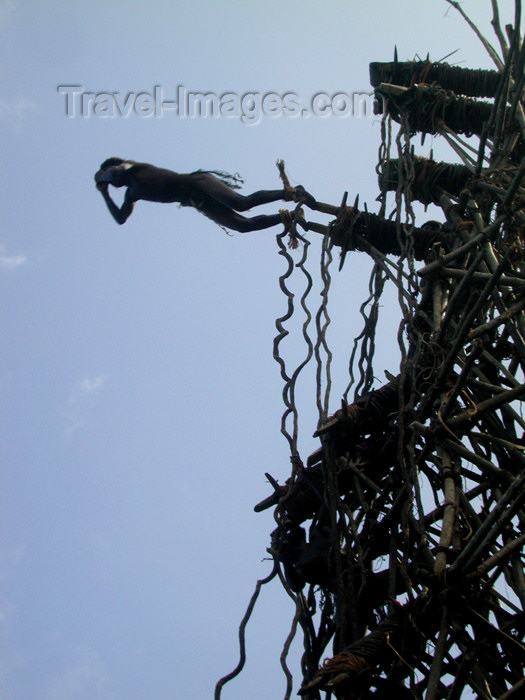 Vanuatu
- The Birthplace of Bungy
Vanuatu
- The Birthplace of Bungy
by Bill Cain
| Travel Articles for Publishers |
Travel-Images.com
|
 Vanuatu
- The Birthplace of Bungy
Vanuatu
- The Birthplace of Bungy
by Bill Cain
For those whose passion is golf, playing a round at St. Andrews in Scotland can be a lifelong ambition. After all, it’s where golf began. And if you’re a baseball fan, a pilgrimage to Cooperstown, NY is just about mandatory because, well, that’s where baseball was born. Interestingly enough, so too is it possible for those who have dangled at the end of a bungy cord to visit this extreme sport’s place of origin. It’s just a little farther away and that much harder to get to.
By now, if you haven’t heard of bungy jumping, you’ve probably been living in a cave for the past 10 - 15 years. But did you ever stop to consider who came up with the hair brained idea of jumping off a bridge with one end of an elastic cord tied to their ankles and the other end to the bridge?
The concept wasn’t dreamt up by an entrepreneurial capitalist looking to make a fortune, but by a tribe on the South Pacific island of Pentacost in what is now the nation state of Vanuatu. Known as the New Hebrides before 1980 when it achieved independence from Great Britain, Vanuatu is a group of eighty-three islands on the eastern edge of the Coral Sea, and which lie about 400 miles west of Fiji. Of all the islands that make up this relatively unknown country on the other side of the world, Pentacost is the only one in the archipelago where the N’gol land diving ritual, as it’s called locally, is practiced.
The similarities between the modern day
interpretation and the South Seas original are readily apparent, except
for the safety factor. Despite all its unnerving outward appearances, commercial
bungy jumping had the element of danger removed from the very beginning
– rare accidents notwithstanding. Modern technology, from the precise manufacturing
of the bungy cords and related equipment, to the predetermined safety of
the jump sites, has virtually eliminated the risk factor. So while it may
look scary and require great courage to jump from a high place, the chances
of injury, let alone fatality, are actually quite small. The same can not
be said of those who jump on Pentacost Island, from where the westernized
sport was inspired.
Few indigenous ceremonies are as intriguing for those fortunate enough to witness it first hand. For unlike its modern-day successor, jumping here is devoid of any technological innovations. It’s practiced exactly the way it was originated hundreds of years ago and the risks are as real now as they were back then.
There are over twenty different N’gol land diving villages which are dedicated sites on Pentacost and jumping takes place for only a few weeks a year through most of the month of May. As the ceremony has deep cultural meaning and significance for the local people, few outsiders are allowed to spectate. I was fortunate enough recently to have been among a small group of passengers on an expeditionary cruise ship who had permission to disembark and then to watch ten jumpers at the village of Wanur on Pentacost. Coincidentally, it was at Wanur in 1974, when the islands were still part of the British Empire, that a visiting Queen Elizabeth watched in horror the last land diving fatality. Despite the clean record since, injuries – some serious – are still reported.
Each year a new location on the side of a steep mountain behind the village of Wanur is selected for the ritual. A small swath of forest is cleared with the cut timber being used to erect a primitive scaffolding from which the selected men will jump. These scaffoldings typically reach 90 – 100 feet in height and have multiple jump platforms at different levels to accommodate jumpers with varying degrees of bravery and experience. Land divers are not obligated, as if they were the unlucky winners of some lottery, but actually volunteer for this. Some jump year after year, with each successive land dive done that much higher on the scaffolding. It’s safe to assume that the divers who jump from the very top of the structure are seasoned “professionals” who have “learned the ropes” and worked through many of their fears at the lower levels.
 The
reasons for jumping are multiple and a bit complex. Island lore says the
practice originated a long time ago when a beaten woman ran away from her
husband. She climbed a tall tree and, just as the angry husband reached
her, she leaped. In anguish or frustration, he jumped after her, not realizing
she had tied vines from the tree around her ankles to brake her fall. She
survived, while he perished. Today men and boys as young as seven climb
the towers and leap from the platforms as a show of strength and as a demonstration
to women that they will not be tricked like the legendary abusive husband.
The
reasons for jumping are multiple and a bit complex. Island lore says the
practice originated a long time ago when a beaten woman ran away from her
husband. She climbed a tall tree and, just as the angry husband reached
her, she leaped. In anguish or frustration, he jumped after her, not realizing
she had tied vines from the tree around her ankles to brake her fall. She
survived, while he perished. Today men and boys as young as seven climb
the towers and leap from the platforms as a show of strength and as a demonstration
to women that they will not be tricked like the legendary abusive husband.
It is also a fertility rite. Jumpers calculate their fall so that, ideally, their heads will just scrape the soil, thus ensuring a successful yam crop next harvesting season.
In a slow, single file procession, my group climbed the steep mountain side to the N’gol site and dispersed along the sides of the landing pit. Several assistants continually groomed the loose soil in the pit to help improve the chances of the softest landing impacts as possible. Like an abstract sculpture, the towering scaffolding tapered to a small peak. In back of the imposing structure, slightly higher up the mountain side, dozens of villagers chanted, danced and stomped the ground in a powerful, impassioned display of support for the land divers. Starting at the lowest level, each diver had his ankles attached to the thick vines by assistants who also climb the tower, with the other end secured to the super structure.
Just as parachutists are advised to “pack
your own chute”, to guarantee and take responsibility for their personal
safety, N’gol land divers must prepare and pre-measure the length of their
own vines. Because the vines are not elasticized like modern day bungy
cords, a miscalculation can prove costly – too short and you could fall
into the bottom of the scaffolding; too long might mean death on impact.
To further enhance their chances of success, divers also strive to become
pure of heart and mind through a cleansing process of meditation beginning
days before their jumps.
One by one they jumped that day – each jump higher than the one before. One by one they landed with a disconcerting thud just a short distance from where I had found a photo vantage point on the steep incline. Twice the vines snapped in a loud crack with no apparent consequences, after which the dazed divers were immediately cut loose from their ankle restraints and comforted by the ground assistants. Amazingly, of the ten jumps that day, none resulted in serious injury.
Back in the village, I mingled freely with many of the jumpers who happily posed for photos. Even though visitors are expected to dress conservatively, the local dress code on Pentacost is shocking to many Westerners. Men, including the land divers, wear a skimpy wrap around their mid section called a namba, which covers the penis, but leaves the scrotum and buttocks completely exposed. Though these men appear naked by our standards, they consider themselves fashionably clothed.
Eighty men and boys were scheduled to jump
during the 2003 N’gol land diving season at Wanur village alone and I had
just witnessed jumpers 21- 30. I wondered as I was leaving if any of the
remaining 50 would suffer serious injuries or if they would all measure
their vines as accurately as the 10 I had observed on this day. I also
wondered, however fleetingly, whether the yam harvest would be a good one
this year.
| see also: travel articles, images, about us, photographers |
|
|
|
|
|
|
|
|
|
|
| Travel Articles |
www.travel-images.com
|